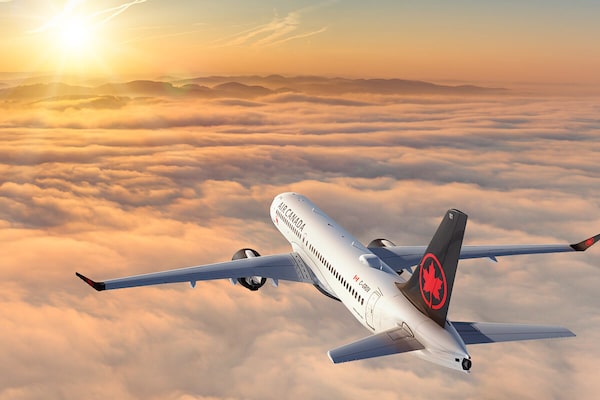
Air Canada debuted the Airbus A220 last week, and plans to introduce 44 more by 2022.Supplied
The newest addition to Air Canada’s fleet took its first flight on Jan. 16, 2020.
Designed and manufactured in Canada, the 137-seat Airbus A220-300 raises the bar for reducing environmental impact and enhanced customer experience. It’s also received rave reviews from pilots praising its advanced safety features, high performance and well-designed cockpit.
With 44 more on order, scheduled to fly with the airline by 2022, the A220 is likely to become a fixture on many of Air Canada’s North American routes.
Here’s everything you need to know about the plane and its advanced offerings.
Space to stretch out
The A220’s spacious cabin is one of the key features that set it apart from its competitors and older generations of aircraft.
According to aviation expert and McGill University lecturer John Gradek, the extra space is a result of exceptional design and high-tech materials.
“The curvature of the (aircraft body) determines the space you have,” he says. “Because it's not made out of steel like an Airbus 320 or a Boeing 737 – it's made out of aluminium and composite – they could mold the [plane] to allow for larger overhead bins and bigger windows.”
In fact, the A220’s drop-down overhead bins and cabin windows are the largest in its class. And the extra space translates to many travellers’ most important consideration: “The key selling point for the A220 is the width of the seat,” Gradek says.
“It has the widest seat in economy class of any airplane around. It's got a 19-inch width and everybody else's seats are only 17 inches. When you sit in the A220 seat, you feel the space. Even though it's only two inches, you definitely feel it.”

The Airbus A220 is setting the standard in seat size and customer comfort.Supplied
Air Canada’s economy class also offers travellers a personal seatback touchscreen entertainment system with more than 1,000 hours of content in 15 languages. Things are even more impressive in North America Business Class, with guaranteed access to a window or aisle, adjustable head and footrests, and a wine list curated by sommelier Veronique Rivest.
Given all these features flyers might be forgiven for thinking they’re on a larger, long-haul jumbo jet.
That’s the whole idea, says Mark Galardo, vice-president of network planning at Air Canada: “With the introduction the Airbus A220, our customers will be able to enjoy the up-to-date amenities and comfort they have come to enjoy and expect from our larger planes, in a state-of-the-art, single-aisle aircraft.”
A greener way to fly
As a growing number of Canadians become increasingly concerned about climate change – four in five believe it’s a serious problem according to a 2019 Abacus Data poll – the A220 also offers an eco-friendlier way to fly.
“The Airbus A220 achieves a 20 per cent reduction in emissions per seat when compared to similar aircraft thanks to the geared turbofan engines and the lighter materials used throughout the aircraft,” Galardo says.
That means the plane uses less fuel and burns it cleaner. In addition to the reduction in carbon emissions, the A220 engines are 50 per cent below the legal standard for nitrous oxide emissions.

Air Canada flyers can expect over 1,000 hours of entertainment at their fingertips on the Airbus A220.Supplied
The high-tech engine also makes the plane much quieter than other aircraft, with a 50 per cent smaller noise footprint than the planes of previous generations.
Canadian made, Canadian designed
Though the A220 is branded as an Airbus product, it was designed in Canada as the Bombardier C-series before the French aerospace giant came on board with a controlling stake and international marketing muscle.
According to Gradek, the jets – produced at Bombardier’s Mirabel site near Montreal – are extremely important to the Canadian aerospace industry. Bombardier initially had difficulty drumming up sales but after Air Canada’s move to add the jet to its fleet, several other airlines followed suit.
Galardo says that while supporting the local aerospace sector was a consideration, the decision to purchase the A220 was based on the plane’s merits. He believes it’s simply a superior product.
“The A220 is a testament to Canadian innovation and ingenuity, and we’re tremendously proud to have played a key part in the success of this airplane.”
Advertising feature produced by Globe Content Studio. The Globe’s editorial department was not involved.